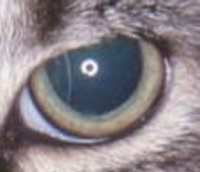 Back
Back
BLUE EYE First broadcast on www.provet.co.uk |
This information is provided by Provet for educational purposes only.
You should seek the advice of your veterinarian if your pet is ill as only he or she can correctly advise on the diagnosis and recommend the treatment that is most appropriate for your pet.
The term "blue eye" is widely used to describe the blue discoloration of the eye which occurs occasionally as a vaccine side-effect- but the sign can be associated with a variety of different conditions.
The front part of the eye (the cornea) is normally clear and transparent. When you look into a normal eye you can see the colored iris and, in the centre the circular, black pupil.
The pupil varies in size depending upon the brightness of the surroundings. In bright light the pupil gets smaller to reduce the amount of light getting to sensitive cells at the back of the eye (the retina). If light is reflected back from retina you see a glare through the pupil which can be a variety of colors - often yellow, green, or red.
In some species eg snakes, the cornea of the eye appears blue, then white prior to shedding of the skin.
In other animals if the cornea is injured in someway, if it gets inflamed, if there is disease within the eye (eg uveitis) or if pressure builds-up inside the eye (glaucoma) fluid moves into and swells the cornea (called oedema). It is this swelling that makes the cornea appear to be cloudy and "blue".
A cat with blue eye and congestion of the white of the eye (sclera)
Blue eye usually only affects one eye but in some cases, such as this dog, it can affect both eyes at the same time.
Blue eye can occur in dogs recovering from natural canine adenovirus infection, and in the past some animals (particularly from certain breeds of dog, including the Afghan Hound) used to develop "blue eye" as a reaction 10-14 days after vaccination with a live attenuated form of vaccine against canine adenovirus type I .
An Afghan with unilateral blue eye following vaccination
When this occurred the blueness (which was caused by an immune reaction to the virus) usually went away with time, but some dogs were left with permanent discoloration. Nowadays this form of "blue eye" is seen much less frequently due to the development of vaccines against canine adenovirus type II which do not cause the side-effect.
Some breeds of dog (the Chihuahua and the Boston Terrier) also get "blue eye" due to an inherited defect (called corneal endothelial dystrophy).
Occasionally old dogs develop "blue eye" especially the short-nosed (brachycephalic) breeds.
Treatment should be given promptly, because if left untreated some cases will go on to develop glaucoma - which is a serious disease that can lead to loss of sight.
So, your veterinarian should be consulted as soon as possible if you notice a blue discoloration to your pets eye.
Updated October 2013



